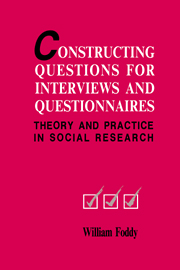Book contents
- Frontmatter
- Contents
- Tables
- Figures
- Preface
- Chapter 1 An initial statement of the problem
- Chapter 2 A theoretical framework
- Chapter 3 Defining topics properly
- Chapter 4 Formulating intelligible requests for information
- Chapter 5 Contextual influences on respondents' interpretations of questions
- Chapter 6 The need to provide response frameworks
- Chapter 7 The limitations of human memory
- Chapter 8 Filters: establishing the relevance of questions to respondents
- Chapter 9 Reducing question threat
- Chapter 10 The open vs. closed questions debate
- Chapter 11 Measuring attitudes
- Chapter 12 Checks to ensure that questions work as intended
- Chapter 13 Concluding comments
- The tap paradigm
- References
- Index
- Acknowledgements
Chapter 3 - Defining topics properly
Published online by Cambridge University Press: 04 September 2009
- Frontmatter
- Contents
- Tables
- Figures
- Preface
- Chapter 1 An initial statement of the problem
- Chapter 2 A theoretical framework
- Chapter 3 Defining topics properly
- Chapter 4 Formulating intelligible requests for information
- Chapter 5 Contextual influences on respondents' interpretations of questions
- Chapter 6 The need to provide response frameworks
- Chapter 7 The limitations of human memory
- Chapter 8 Filters: establishing the relevance of questions to respondents
- Chapter 9 Reducing question threat
- Chapter 10 The open vs. closed questions debate
- Chapter 11 Measuring attitudes
- Chapter 12 Checks to ensure that questions work as intended
- Chapter 13 Concluding comments
- The tap paradigm
- References
- Index
- Acknowledgements
Summary
This chapter focuses upon the first three assumptions that were identified as underpinning survey research at the start of the last chapter. They were: that the researcher has clearly defined the required information; that the respondents have the required information; and that the respondents can access the required information under the conditions of the research situation. All three relate to the need for questions to be directed at properly defined, accessible information. And all three relate to the first step in a question–answer cycle (figure 3.1, page 26).
The researcher has clearly defined the required information
As with many assumptions that appear at first sight to be straightforward, this assumption is more complex than it first appears to be. To begin with, it implies that the researcher must begin with a clear definition of the topic to be investigated. It also implies that the researcher has a clear understanding of the kind of information about the topic that will satisfy the theoretical or practical reasons for carrying out the research. It is worth looking more closely at each of these implications in turn.
The researcher has clearly defined the topic
Some years ago the author acted as a methodological consultant for a community self-survey project. A small town had received a grant to carry out a survey of the residents' views about how their town should be developed. A committee of community leaders had been formed to plan the project and develop a questionnaire.
- Type
- Chapter
- Information
- Constructing Questions for Interviews and QuestionnairesTheory and Practice in Social Research, pp. 25 - 37Publisher: Cambridge University PressPrint publication year: 1993

